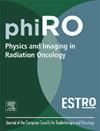靶体积磁共振测温与腔内探针测温在热疗监测中的比较
IF 3.3
Q2 ONCOLOGY
引用次数: 0
摘要
背景与目的热疗是指将目标温度升高到39-44°C,使用温度探头进行监测。然而,这些提供了有限的空间信息,只采样了几个离散的位置。磁共振(MR)测温目前为热疗期间的三维(3D)温度监测提供了一种选择。本研究将腔内探针测得的温度与mr测得的温度进行了比较和关联(1)包含腔内探针的解剖区域和(2)热疗靶体积(HTV), HTV位于距离探针一定距离的位置,代表了临床兴趣的主要区域。方法对13例局部晚期宫颈癌(LACC)患者进行放疗加热疗治疗。热疗监测采用腔内探针和磁共振测温。将核磁共振温度与腔内探针温度进行比较。重复测量相关性应用于在所有数据和患者特定的基础上关联HTV中的探针和核磁共振温度。结果基于smr的探针位置温度与探针测量值吻合良好(绝对误差中位数≤0.7°C)。在HTV中,基于mr的温度与探针温度的绝对误差中值为0.5°C。mri和基于探针的HTV温度之间的重复测量相关性(rrm)在所有数据中为0.74 - 0.79,在患者特定基础上为0.64-0.96。结论smr测温技术在HTV温度分布的回顾性评价中具有良好的应用前景。虽然目前它在实时治疗指导方面的可靠性仍然有限,但我们的研究结果支持进一步发展热疗的更广泛临床应用。本文章由计算机程序翻译,如有差异,请以英文原文为准。
Magnetic resonance thermometry in the target volume versus intraluminal probe thermometry for hyperthermia treatment monitoring
Background and purpose
Hyperthermia, the elevation of target temperature to 39–44 °C, is monitored using temperature probes. However, these provide limited spatial information, sampling only a few discrete locations. Magnetic resonance (MR) thermometry currently offers an option for three-dimensional (3D) temperature monitoring during hyperthermia. This study compares and correlates temperatures measured by intraluminal probes with MR-based temperatures in (1) the anatomical region containing the intraluminal probes and (2) the hyperthermia target volume (HTV), located at a distance from the probes and representing the primary region of clinical interest.
Methods
Thirteen locally advanced cervical cancer (LACC) patients treated with radiotherapy and hyperthermia were included. Hyperthermia was monitored using intraluminal probes and MR thermometry. MR-based temperatures were compared to intraluminal probe temperatures. Repeated measures correlation was applied to correlate probe and MR-based temperatures in the HTV across all data and on a patient-specific basis.
Results
MR-based temperatures at probe locations showed good agreement with probe measurements (median absolute error ≤ 0.7 °C). In the HTV, MR-based temperatures deviated by a median absolute error of 0.5 °C from probe temperatures. Repeated measures correlations (rrm) between MR and probe-based HTV temperatures ranged from 0.74 to 0.79 across all data and 0.64–0.96 on a patient-specific basis.
Conclusions
MR thermometry demonstrated promising performance for retrospective evaluation of temperature distributions in the HTV. While its current reliability for real-time treatment guidance remains limited, our results support further development towards broader clinical implementation in hyperthermia.
求助全文
通过发布文献求助,成功后即可免费获取论文全文。
去求助
来源期刊

Physics and Imaging in Radiation Oncology
Physics and Astronomy-Radiation
CiteScore
5.30
自引率
18.90%
发文量
93
审稿时长
6 weeks
 求助内容:
求助内容: 应助结果提醒方式:
应助结果提醒方式:


